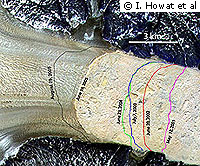Global warming studied more closely than ever, but intervention may be too late.
The European Space Agency's (ESA) GLOBCARBON project has reached a mid-point in its ten-year survey into climate change, with participants coming together to discuss the findings so far, including data for years 1998 to 2003. The project uses information gleaned from satellites to give the most accurate picture yet of how the Earth's eco-system is changing due to global warming. This milestone comes as the UK's meteorological office publishes a report claiming that moves to curtail climate change may be too late, and that the Greenland ice-sheet is now threatened. The GLOBCARBON project aims to take a ten-year 'snapshot' of the Earth's vegetation by measuring the rates of growth or destruction of specific types of vegetation, for example Burnt Area Estimates (fire affected vegetation), Leaf Area Index (or area of green leaf exposed to light for photosynthesis) and other measures which are then combined to give highly accurate software simulations. When the numbers gleaned from the five separate vegetation sensors on satellites have been crunched, the project will provide a better insight into how the carbon-cycle has been affected by man's intervention. 'GLOBCARBON is definitely a useful product for the carbon modelling community. Information about Leaf Area Index is important because it gives us an ability to constrain the amount of green biomass available for photosynthesis and gas exchange through evapo-transpiration,' explained Dr Tristan Quaife of Sheffield's Centre for Terrestrial Carbon Dynamics. 'These are probably the two key processes controlling carbon exchange with the atmosphere, so with better knowledge of Leaf Area Index and its dynamics we have a better chance of estimating the primary productivity of the ecosystem,' he said. The system will also give more information relating to the vegetation cycle, which will help us understand how plants absorb carbon. However, if the UK report 'Avoiding Dangerous Climate Change', to be published on 1 February, is accurate, then the damage may have already been done. The report looks particularly at the Greenland ice-sheet, which contains the majority of the world's non-Antarctic fresh water. In the report's preface, UK Prime Minister Tony Blair says: 'It is clear from the work presented that the risks of climate change may well be greater than we thought. 'It is now plain that the emission of greenhouse gases, associated with industrialisation and economic growth from a world population that has increased six-fold in 200 years, is causing global warming at a rate that is unsustainable.' The EU has set a target for global warming to be limited to two degrees Celsius. While a rise of two degrees seems insignificant, the effect would be amplified in temperate areas, and could be enough to severely affect global food production, cause large-scale migrations of people from too-dry areas, loss of 97 per cent of coral reefs, loss of Arctic sea ice and spread of malaria. Worryingly, an increase in global temperature of two degrees would also spell the beginning of the end for the Greenland ice-sheet. The melting of this ice-sheet could raise water levels by seven metres globally, but melting could take 1,000 years. Once started, this change is likely to be irreversible. The consensus seems to be that to stabilise global warming, the levels of carbon dioxide in the atmosphere need to stabilise. Carbon dioxide levels have increased from 275 ppm prior to the industrial revolution to 380ppm now. Experts believe that a maximum carbon dioxide level of 450ppm would be enough to halt global warming at two degrees. To achieve the target of 450ppm, global carbon emissions will have to peak by 2015, and then decrease by 30-40 per cent compared to 1990 levels by 2050. The UK government's Chief Scientific Advisor Sir David King said that 'We're going to be at 400 parts per million in ten years time, I predict that without any delight in saying it. But no country is going to turn off a power station which is providing much-desired energy for its population to tackle this problem - we have to accept that. To aim for 450 [ppm] would, I am afraid, seem unfeasible,' he said.
Countries
United Kingdom



